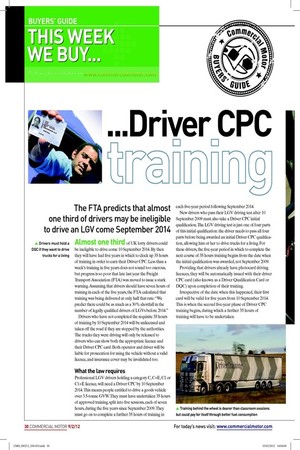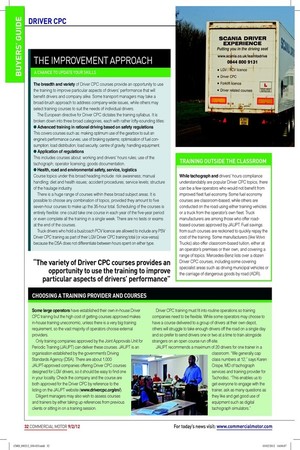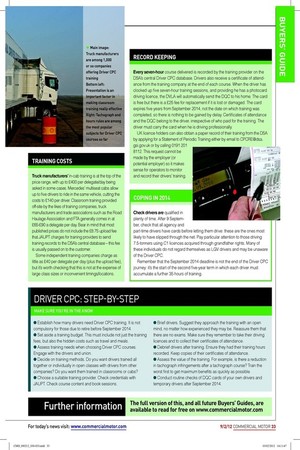THIS WEEK WE BUY...
Page 22

Page 23

Page 24

Page 25

If you've noticed an error in this article please click here to report it so we can fix it.
Full guide available at www.commercialmotor.com
...Driver CPC
The FTA predicts that almost one third of drivers may be ineligible to drive an LGV come September 2014
Almost one third of UK lorry drivers could be ineligible to drive come 10 September 2014. By then they will have had ive years in which to clock up 35 hours of training in order to earn their Driver CPC. Less than a week’s training in ive years does not sound too onerous, but progress is so poor that late last year the Freight Transport Association (FTA) was moved to issue a stark warning. Assuming that drivers should have seven hours of training in each of the ive years, the FTA calculated that training was being delivered at only half that rate: “We predict there could be as much as a 30% shortfall in the number of legally qualiied drivers of LGVs before 2014.”
Drivers who have not completed the requisite 35 hours of training by 10 September 2014 will be unlicensed and taken off the road if they are stopped by the authorities. The trucks they were driving will only be released to drivers who can show both the appropriate licence and their Driver CPC card. Both operator and driver will be liable for prosecution for using the vehicle without a valid licence, and insurance cover may be invalidated too.
What the law requires
Professional LGV drivers holding a category C, C+E, C1 or C1+E licence, will need a Driver CPC by 10 September 2014. This means people entitled to drive a goods vehicle over 3.5-tonne GVW. They must have undertaken 35 hours of approved training, split into ive sessions, each of seven hours, during the ive years since September 2009. They must go on to complete a further 35 hours of training in each ive-year period following September 2014.
New drivers who pass their LGV driving test after 10 September 2009 must also take a Driver CPC initial qualiication. The LGV driving test is just one of four parts of this initial qualiication: the driver needs to pass all four parts before being awarded an initial Driver CPC qualiication, allowing him or her to drive trucks for a living. For these drivers, the ive-year period in which to complete the next course of 35 hours training begins from the date when the initial qualiication was awarded, not September 2009.
Providing that drivers already have photocard driving licences, they will be automatically issued with their driver CPC card (also known as a Driver Qualiication Card or DQC) upon completion of their training.
Irrespective of the date when this happened, their irst card will be valid for ive years from 10 September 2014. This is when the second ive-year phase of Driver CPC training begins, during which a further 35 hours of training will have to be undertaken.
THE COMPLIANCE APPROACH
The most basic compliance approach is to leave it to the drivers to organise their own Driver CPC training and then ask to see their Driver Qualification Cards by 10 September 2014. Apart from being unwise for the business reasons mentioned above, this is liable to test drivers’ loyalty to breaking point.
Assuming operators reject this strategy, now is a good time to organise Driver CPC training at a minimum cost. The sluggish uptake of training so far means that many of the 1,000 or so companies providing LGV Driver CPC training are experiencing a shortfall in their projected throughput and so have capacity to spare. That makes it a buyer’s market – for now. That will change as we near the deadline and training slots disappear.
Taking the compliance approach means not having to worry about the quality or content of the training, just accumulating 35 hours for each driver at minimum cost. Classroom-based Driver CPC courses can cost as little as £40-£50 per trainee for each seven-hour session, and many sessions are still available on Fridays and Saturdays when they may cause the least disruption to work patterns.
EXEMPTIONS
Drivers of military or emergency services vehicles over 3.5-tonne GVW do not require a Driver CPC – but only when driving those vehicles. If driving a normal truck to deliver a load, they need a Driver CPC.
Similarly, technicians driving trucks for maintenance-related reasons do not need a Driver CPC, but they do if they are delivering a load for commercial purposes.
Also exempt is the driver of a vehicle that “carries material or equipment to be used by the driver in the course of his or her work, provided that driving the vehicle is not the driver’s principal activity”.
So, for example, a scaffolder driving a lorry carrying scaffolding would not need a Driver CPC provided he can demonstrate that scaffolding, rather than driving, is his main activity.
There are sure to be grey areas where the activity split is less clear-cut: these interpretations will be only fully tested in court when the first drivers are prosecuted for lacking a Driver CPC.
THE IMPROVEMENT APPROACH
A CHANCE TO UPDATE YOUR SKILLS The breadth and variety of Driver CPC courses provide an opportunity to use the training to improve particular aspects of drivers’ performance that will benefit drivers and company alike. Some transport managers may take a broad-brush approach to address company-wide issues, while others may select training courses to suit the needs of individual drivers.
The European directive for Driver CPC dictates the training syllabus. It is broken down into three broad categories, each with rather lofty-sounding titles: • Advanced training in rational driving based on safety regulations This covers courses such as: making optimum use of the gearbox to suit an engine’s performance curves; use of braking systems; optimisation of fuel consumption; load distribution; load security; centre of gravity; handling equipment.
• Application of regulations This includes courses about: working and drivers’ hours rules; use of the tachograph; operator licensing; goods documentation.
• Health, road and environmental safety, service, logistics Course topics under this broad heading include: risk awareness; manual handling; diet and health issues; accident procedures; service levels; structure of the haulage industry.
There is a huge range of courses within these broad subject areas. It is possible to choose any combination of topics, provided they amount to five seven-hour courses to make up the 35-hour total. Scheduling of the courses is entirely flexible: one could take one course in each year of the five-year period or even complete all the training in a single week. There are no tests or exams at the end of the courses.
Truck drivers who hold a bus/coach PCV licence are allowed to include any PSV Driver CPC training as part of their LGV Driver CPC training total (or vice-versa) because the DSA does not differentiate between hours spent on either type.
TRAINING OUTSIDE THE CLASSROOM
While tachograph and drivers’ hours compliance understandably are popular Driver CPC topics, there can be a few operators who would not benefit from improved fleet fuel economy. Some fuel economy courses are classroom-based, while others are conducted on the road using either training vehicles or a truck from the operator’s own fleet. Truck manufacturers are among those who offer roadbased courses approved by JAUPT. Fuel savings from such courses are reckoned to quickly repay the cost of the training. Some manufacturers (like Volvo Trucks) also offer classroom-based tuition, either at an operator’s premises or their own, and covering a range of topics. Mercedes-Benz lists over a dozen Driver CPC courses, including some covering specialist areas such as driving municipal vehicles or the carriage of dangerous goods by road (ADR).
TRAINING COSTS
Truck manufacturers’ in-cab training is at the top of the price range, with up to £400 per delegate/day being asked in some cases. Mercedes’ multiseat cabs allow up to five drivers to ride in the same vehicle, cutting the costs to £140 per driver. Classroom training provided off-site by the likes of training companies, truck manufacturers and trade associations such as the Road Haulage Association and FTA generally comes in at £65-£90 a delegate per day. Bear in mind that most published prices do not include the £8.75 upload fee that JAUPT charges for training providers to send training records to the DSA’s central database – this fee is usually passed on to the customer.
Some independent training companies charge as little as £40 per delegate per day (plus the upload fee), but it’s worth checking that this is not at the expense of large class sizes or inconvenient timings/locations.
RECORD KEEPING
Every seven-hour course delivered is recorded by the training provider on the DSA’s central Driver CPC database. Drivers also receive a certificate of attendance from the training company at the end of each course. When the driver has clocked up five seven-hour training sessions, and providing he has a photocard driving licence, the DVLA will automatically send the DQC to his home. The card is free but there is a £25 fee for replacement if it is lost or damaged. The card expires five years from September 2014, not the date on which training was completed, so there is nothing to be gained by delay. Certificates of attendance and the DQC belong to the driver, irrespective of who paid for the training. The driver must carry the card when he is driving professionally.
UK licence holders can also obtain a paper record of their training from the DSA by applying for a Statement of Periodic Training either by email to CPCRE@dsa. gsi.gov.uk or by calling 0191 201 8112. This request cannot be made by the employer (or potential employer) so it makes sense for operators to monitor and record their drivers’ training.
COPING IN 2014
Check drivers are qualified in plenty of time. After 9 Septem ber, check that all agency and part-time drivers have cards before letting them drive: these are the ones most likely to have slipped through the net. Pay particular attention to those driving 7.5-tonners using C1 licences acquired through grandfather rights. Many of these individuals do not regard themselves as LGV drivers and may be unaware of the Driver CPC.
Remember that the September 2014 deadline is not the end of the Driver CPC journey: it’s the start of the second five-year term in which each driver must accumulate a further 35 hours of training.
CHOOSING A TRAINING PROVIDER AND COURSES
Some large operators have established their own in-house Driver CPC training but the high cost of getting courses approved makes in-house training uneconomic, unless there is a very big training requirement, so the vast majority of operators choose external providers.
Only training companies approved by the Joint Approvals Unit for Periodic Training (JAUPT) can deliver these courses. JAUPT is an organisation established by the government’s Driving Standards Agency (DSA). There are about 1,000 JAUPT-approved companies offering Driver CPC courses designed for LGV drivers, so it should be easy to find one in your locality. Check the company and the course are both approved for the Driver CPC by reference to the
listing on the JAUPT website (www.drivercpc.org/en/).
Diligent managers may also wish to assess courses and trainers by either taking up references from previous clients or sitting in on a training session. Driver CPC training must fit into routine operations so training companies need to be flexible. While some operators may choose to have a course delivered to a group of drivers at their own depot, others will struggle to take enough drivers off the road on a single day and so prefer to send drivers one or two at a time to train alongside strangers on an open course run off-site.
JAUPT recommends a maximum of 20 drivers for one trainer in a classroom. “We generally cap class numbers at 12,” says Karen Crispe, MD of tachograph services and training provider for Tachodisc. “This enables us to get everyone to engage with the trainer, ask as many questions as they like and get good use of equipment such as digital tachograph simulators.”
DRIVER CPC: STEP-BY-STEP
MAKE SURE YOU’RE IN THE KNOW • Establish how many drivers need Driver CPC training. It is not compulsory for those due to retire before September 2014.
• Set aside a training budget. This must include not just the training fees, but also the hidden costs such as travel and meals.
• Assess training needs when choosing Driver CPC courses. Engage with the drivers and union.
• Decide on training methods. Do you want drivers trained all together or individually in open classes with drivers from other companies? Do you want them trained in classrooms or cabs?
• Choose a suitable training provider. Check credentials with JAUPT. Check course content and book sessions. • Brief drivers. Suggest they approach the training with an open mind, no matter how experienced they may be. Reassure them that there are no exams. Make sure they remember to take their driving licences and to collect their certificates of attendance.
• Debrief drivers after training. Ensure they had their training hours recorded. Keep copies of their certificates of attendance.
• Assess the value of the training. For example, is there a reduction in tachograph infringements after a tachograph course? Train the worst first to get maximum benefits as quickly as possible.
• Conduct routine checks of DQC cards of your own drivers and temporary drivers after September 2014.











































